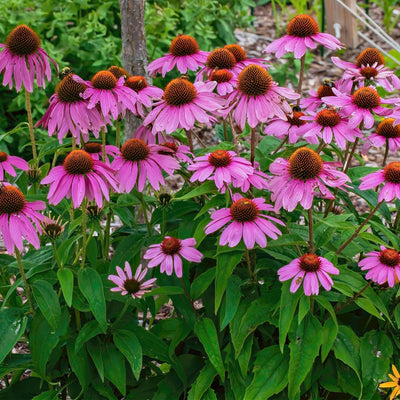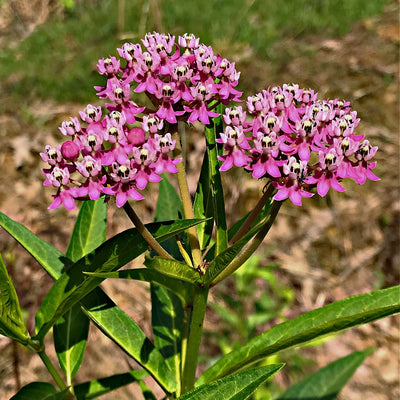The Rising Demand for Native Plants
Why They’re Gaining Popularity
Native plants are becoming more popular. Clients are now requesting specific native plants by name or just asking you to use only native plants in landscaping. Here are some reasons this trend has staying power.
What Are Native Plants?
Native plants are the plants that were growing in the area before settlement by Europeans. The date of this cutoff varies by location. If you are on a seacoast, the cutoff is earlier than if you are in the middle of the country.
Preserve Biodiversity
Biodiversity is the number and variety of species living in an area. Native pollinators evolved to feed on native plants. The insects will disappear if there is only a sea of turfgrass and imported plants. Since insects feed birds and large numbers of other animals, they will also disappear. In addition, insects pollinate around 80% of flowering plants, so there would be no flowers if there were no insects.
Bird And Wildlife Watching
Native plants draw birds and animals that are fun to watch. You will draw even more wildlife if you have a water feature from which the animals can drink. Fountains or bubbling streams help animals find water. Birds nest in native shrubs. Native grasses provide nesting habitat for a variety of small mammals. If you plant a range of native plants that bloom at different times of the year you can have flowers from early spring to late fall.

In the south, redbud trees bloom in early spring. After they are done blooming, other plants such as purple coneflowers bloom and so on until the freeze. Specialist native bees flies, and beetles may only be active for the few weeks their host plant is blooming. Without those plants, the insects will starve.
Balance Habitat Loss
Planting native plants helps offset habitat loss from housing developments and other buildings. Since humans have created the problem, so we must be part of the solution.
No Invasives Here
Native plants are kept in check by several things: the environmental limitations of their native habitat, the insects and other living things that eat them, and the diseases that are native to the area. While they might spread somewhat aggressively in a flower bed, they will not escape and crowd out native species in the wild. Many non-native species have done so. Many of the invasives wildlife managers now battle were brought over for erosion control and distributed to farmers by the government.
Easy Maintenance
Plants that are native to the area can live off the rainfall in the area once they become established. Fertilizer is usually not needed, and neither are pesticides. Plants come up with ways to combat the insects that evolved to eat them or nest in them, so the plants can survive. Native plants are ideal plants for beginners since they are so hardy and easy to care for.
Because you save on fertilizer and pesticides, native plants are cheaper to grow than pricey imported plants. Remember how much of your time you spend defending roses from black spot and other diseases, and the pesticides you have to use to kill the insects eating them? That is generally not necessary with native plants. Not only does that help wildlife, but it is also safer for the people who have to maintain the landscape because they are not using toxic chemicals as much.
Save HOAs Money
Replacing turf grass in common areas with native plants can save on maintenance costs like mowing. The savings realized by less mowing, fertilizer, and spraying can be significant.
Manage Stormwater
In cities, the huge amount of hardscape such as roads and sidewalks can keep water from absorbing into the soil. Most of the stormwater is channeled into storm drains and into creeks and rivers from there. Planting native species on berms and swales can slow the stormwater and let more of it sink into the soil. Since native species rarely need supplemental water once they are established, they are ideal to use for low maintenance stormwater management.
Green Roofs
Using native plants on green roofs also helps manage stormwater runoff. The plants and soil on the roof soak up the water before it reaches stormwater drains. Green roofs not only benefit pollinators. Studies show that people working in buildings with green roofs use them to take a break and reduce stress.
Community Gardens
Adding borders of native plants around individual plots in community gardens helps ensure the fruits and vegetables are pollinated. It increases yields and makes the property look better.
Mixing Natives And Imported Plants
Unless the house or landscape you maintain has just been constructed, you probably have plants. You don’t have to rip everything out and start over. Mixing native and non-native plants can work very well. As old plants die or just look bad, you can replace them with a suitable native plant. For example, wild strawberries can be used as a ground cover that will feed birds, wildlife, and people while stabilizing soil temperatures, stopping erosion, and keeping weeds at bay.
Sourcing Native Plants
As native plants have grown in popularity, many species have become locally extinct because people have taken them to plant in their landscape. It is never acceptable to harvest native plants from someone else’s property, parks, or other places. Buy them from a reputable nursery that breeds them in captivity or buys them from someone who does. Tennessee Wholesale Nursery only carries responsibly grown plants.
Tips For Incorporating Natives In The Landscape

- Mix natives and non-natives in a shade garden or as a border around your house.
- Reduce the amount of turfgrass by installing beds of native perennials.
- Grow a butterfly garden with native milkweed and nectar rich flowers.
- Establish a rain garden with native species that will withstand a short period of being underwater or flooded. The roots will help stop erosion.
We Can Help
At Tennessee Wholesale Nursery, we grow and sell native plants from all over North America. Give us a call at 931.692.7325 and we will help you find native plants for your area.


